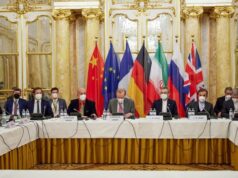Non State Armed Groups Operating around Middle East

Missiles, rockets and drones struck targets around the Middle East this week as the United States, Israel and others clashed with Iran-allied militant groups — with attacks hitting in vital Red Sea shipping lanes, along Israeli-Lebanon borders emptied by fleeing residents and around the region’s crowded capitals and U.S. military installations.
Together, Israel and its U.S. allies were facing two realities they knew all too well going into the war in Gaza: The Gaza-based Hamas militant group is far from alone as it battles for its survival. And by launching an all-out campaign to eliminate Hamas as a fighting force, Israeli and American leaders also are confronting simultaneous attacks from a strengthening defensive alliance of other armed militant groups linked with Hamas and Iran.
This week, the risk of being drawn into a wider, more chaotic and deadlier conflict with an array of regional enemies loomed large. Secretary of State Antony Blinken and other senior Biden administration envoys were traveling to Middle East capitals on Friday to calm tensions and deter further attacks.
Here’s a breakdown of the armed groups facing the United States and Israel in the Middle East, a look at what unites some of them, and what’s different about each.
THE SITUATION
The United States is scrambling to quell attacks by a range of armed groups that are allied to Iran and to each other. They are:
— Hamas in Gaza;
— powerful Hezbollah, the dominant force in Lebanon;
— smaller militias in Iraq and Syria;
— Houthis in the poor Arabian peninsula country of Yemen, who are sometimes seen as more of the loose cannons of the alliance.
All the groups have escalated attacks on U.S., Israeli or global targets within their reach since Israel launched its war in Gaza on Oct. 7, after Hamas’s deadly cross-border raids. The aim of Iran and of the armed groups at large is to aid Hamas with attacks that distract the focus of Israel and the United States, and that make the military, economic and political costs of continuing the war against Hamas too great for Israel and the United States.
The groups don’t necessarily want further additional escalation themselves, given their odds in any all-out confrontation with two of the world’s strongest militaries, experts say. But under the leadership of the late Iranian Gen. Qassem Soleimani, who was killed by the U.S. in 2020, the far-flung array of Iranian-allied militias knitted themselves into a more cohesive network.
They also grew into a common understanding, said Randa Slim, a regional analyst with the Washington-based Middle East Institute: When the survival of any one was threatened, all would rally.
THE PLAYERS:
___
HAMAS
WHAT: Based in Gaza. Founded in 1987 at a time of widespread protests by Palestinians against Israel’s occupation. Has early ties to one of the Sunni world’s most prominent groups, the Muslim Brotherhood, founded in Egypt in the 1920s. Has vowed to annihilate Israel and has carried out suicide bombings and other deadly attacks on civilians and Israeli soldiers.
BACKGROUND: Hamas seized control of Gaza by force in 2007, the year after it won parliamentary elections there with 44% of the vote. Israel has kept Gaza under a devastating blockade ever since, restricting movement of people and goods in and out of the territory. Hamas receives backing from Arab and Muslim countries, including Qatar and Turkey. Although a Sunni Muslim group, Hamas leaders have moved closer to Shiite Muslim Iran and its allies over the years. Hamas’s Oct. 7 attacks in Israel were seen by many as Hamas’s bid to reclaim relevance on the world stage. Israel’s far-right government had sidelined any attempt at a negotiated Israeli-Palestinian political agreement, and world attention faded away.
HEZBOLLAH
WHAT: Formed in 1982 in response to the Israeli invasion of Lebanon, where it is based. One of the strongest members of the Iran-allied alliance, militarily and organizationally. A Shiite Muslim group. Took part in repeated attacks against the United States through the mid-1990s, including the deadly 1983 bombing of a U.S. Marines barrack in Beirut, Lebanon’s capital. Has participated in Lebanon’s government since 1992. Its military wing is stronger than the country’s armed forces.
BACKGROUND: A 2006 war with Israel provoked by Hezbollah’s kidnapping of Israeli soldiers devastated southern Lebanon and Beirut. Many ordinary Lebanese are deeply fearful of a new war with Israel in the wake of the Gaza fighting. Wary of a repeat of the war itself, Hezbollah has lobbed rockets and missiles across its southern border into Israel since the start of the war in Gaza, losing fighters daily in return fire, but held back from further dramatic escalation. That may have changed with a presumed Israeli strike this week that killed a Hamas leader sheltering in Lebanon. Hezbollah leader Hassan Nasrallah said Friday that his group had to retaliate, or else all of Lebanon would be vulnerable to Israeli attack.
HOUTHIS
WHAT: Based in Yemen, overseeing one of the world’s most vital shipping routes for oil and other trade. Have launched rockets, missiles and drones at commercial vessels during the Gaza war. Forced some major shippers to change route and threatens a potentially major toll on the world’s economy. Formally known as Ansar Allah. Had its start as one of several armed groups vying internally for power in fractured, impoverished Yemen. While Shiite Muslim, it’s of a different branch than Iran. Group’s motto calls for destruction of Israel and the United States, though it has been largely focused on affairs in Yemen.
BACKGROUND: At odds with Yemen’s government, Houthis seized control of Yemen’s capital in 2014 and soon controlled much of the north. After Saudi Arabia and the United Arab Emirates opened attack in 2015 in an unsuccessful attempt to rout the Houthis, the Houthis moved increasingly close to Iran as a source of materiel support.
Saudi and U.S. attempts to formally end the Saudi-led war in Yemen have failed to bring Yemen’s war to a close, but had succeeded in stopping what were sporadic missile and drone strikes by the Houthis against their richer Gulf neighbors. The Houthis, who have limited popular support in Yemen outside of their immediate base, are seen as more independent of Iran in their actions than some of the other groups in the alliance. The strikes on shipping since Israel launched its campaign in Gaza are some of the Houthis’ first outward-facing attacks, other than at its Gulf enemies.
IRAN-ALLIED MILITIAS IN SYRIA AND IRAQ
WHAT: Array of smaller Iranian-backed militant groups that have battled with U.S. and coalition forces in Iraq and Syria for years. Mount sporadic attacks against bases in the region where U.S. troops are deployed to fight Islamic State group insurgents.
BACKGROUND: There has been a dramatic spike in attacks by Iran’s proxies in those two countries since the open of the war between Israel and Hamas. Iraq says it is working with the U.S. to contain the militias there. On Thursday, the U.S. unleashed an airstrike against the headquarters of an Iran-backed militia in central Baghdad, killing a high-ranking militia commander. It was an attempt to discourage more attacks.
THE ISLAMIC STATE, AL-QAIDA AND OTHER ARMED SUNNI MUSLIM GROUPS
WHAT: Israel’s deadly military campaign in Gaza, and the United States’ support for it, are sparking calls to action by violent extremist groups that have long battled the West and other enemies.
BACKGROUND: On Thursday, a spokesman for the Islamic State called on Muslims around the world to carry out killings in what he said would be vengeance for the people of Gaza. “Oh lions of Islam, hunt your prey — the Jews, Christians, and their allies — in the streets and alleyways of America, Europe, and the world,” Abu Hudhayfa al-Ansar said in a speech transcribed by the SITE intelligence group. “Break into their homes, kill them, and torment them in every way you can.” (AP)




